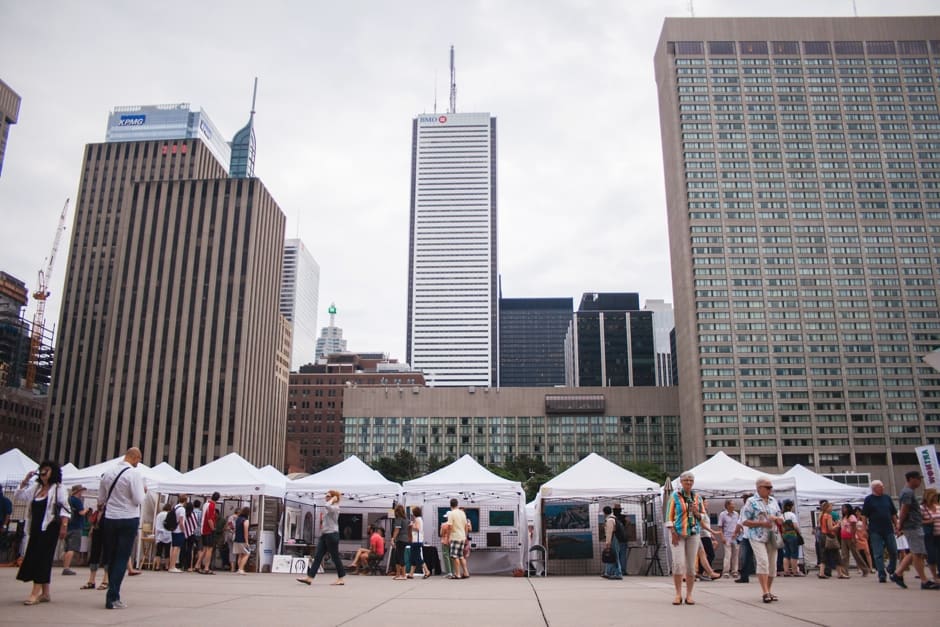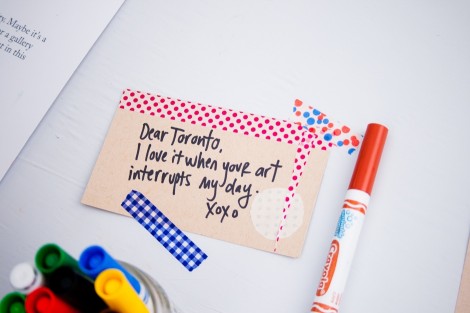This past Sunday, I arrived to a sunny and people-filled Nathan Phillips Square to the view of a horizon of white tents and, upon further exploration, a staggering amount of art.
The Toronto Outdoor Art Exhibition is advertised as the “fresh air” alternative to traditional galleries and showings. It first opened in 1961, making it the largest juried and longest running outdoor art showing in Canada. It is also a registered nonprofit organization. The goal of the organization is to make both art and artists accessible to the public, and to remove the formality of traditional art viewings. With over 100,000 visitors every year, it’s safe to say that strategy is working.
I began weaving through the tents and was greeted by what I had first expected: large, impressive abstracts and landscapes. My attention was grabbed a few rows up by the whimsical, triangular flags strung across the front of one tent that spelled out the name of its inhabitant, artist Ness Lee. Several of the flags bordering her name had the illustrated faces of Sumo wrestlers, which I learned is one of her trademark images. Her work was an assortment of illustrations on paper, pillows, pins, and ceramics, all featuring entertaining characters: a sumo wrestler, a dachshund, and a black cat; or speech bubbles with sassy phrases such as “go away.” Her inspiration comes from having fun; as she puts it, she likes to “get a little dirty, a little cute, a little bitchy.”
I spoke next with Sean Galbraith, who specializes in medium and large format film photography of architectural abandonments. By day, he is an urban planner. His hobby of “recreational trespassing” eventually gave way to self-training in digital and film photography. His works are impressive and haunting; they powerfully illustrate what he describes as “the disposal of economy when you can throw away an entire city.”
By contrast, Claudette Losier’s acrylic paintings breathe vibrancy and life into the often grey cityscape of Toronto. Most often, she paints night scenes, yet her color palette is comprised primarily of neon. She draws from her background of painting florals to influence her recent, entirely urban work.
One of the most engaging mixed media displays was the work by artist Karen Lynch. All of her works are different, adding to the look of authenticity created by her use of wood paneling, chicken wire, and delightful phrases. One of the pieces was a shoebox-sized frame with bark running vertically through the middle, made to look like a tree trunk. Lynch had mounted small pieces of square wiring at the bottom, suggestive of ladders for climbing the tree to an imaginary world.
Becca Wallace photographs vintage toy cars, robots and miniature humans against bright backdrops, which alone could fill a collection of Pantone’s greatest hues. Her work comprised some of the most playful featured at the exhibition and aligns with the joy she gets from “seeing peoples’ smiles” as they view her work. My personal favourites were the series with cars or animals stacked on top of one another.
My final stop was at the tent of Haliburton-based artist Jennifer Posti. Her drawing and painting series combines wild animals as subjects, mirror imagery and negative space, and patterns from art history (while all on square canvases). Each piece incorporates one animal and one pattern; in the case of a porcupine portrait, the golden quills become the pattern. She cites Byzantine artwork as one of many art history influences. Working with the natural shape of deer, muskies, porcupines, and loons, Posti creates portraits of beautiful contrasts.
Like many of the artists, it was my first visit to the Toronto Outdoor Art Exhibition. It was easily one of the best experiences I’ve had looking at visual art. The atmosphere was casual and comfortable, making it easy to talk with the artists and learn about their work as they too are happy — and a tad sweaty — under the hot sun. I wouldn’t hesitate to go back, and indeed now find myself wishing it took place more than one weekend per year.



